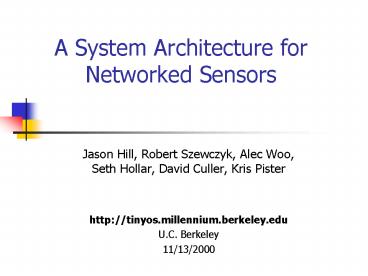A System Architecture for Networked Sensors - PowerPoint PPT Presentation
1 / 25
Title:
A System Architecture for Networked Sensors
Description:
... Sensors. Jason Hill, Robert Szewczyk, Alec Woo, Seth Hollar, David Culler, Kris Pister ... How do you combine sensing, communication and computation into a ... – PowerPoint PPT presentation
Number of Views:36
Avg rating:3.0/5.0
Title: A System Architecture for Networked Sensors
1
A System Architecture for Networked Sensors
- Jason Hill, Robert Szewczyk, Alec Woo, Seth
Hollar, David Culler, Kris Pister - http//tinyos.millennium.berkeley.edu
- U.C. Berkeley
- 11/13/2000
2
Computing in a cubic millimeter
- Advances in low power wireless communication
technology and micro-electromechanical sensors
(MEMS) transducers make this possible - How do you combine sensing, communication and
computation into a complete architecture - What are the requirements of the software?
- How do you evaluate a given design?
3
Ad hoc sensing
- Autonomous nodes self assembling into a network
of sensors - Sensor information propagated to central
collection point - Intermediate nodes assist distant nodes to reach
the base station - Connectivity and error rates used to infer
distance
Base Station
4
Organization
- The Vision
- Hardware of today
- Software Requirements
- TinyOS system architecture
- System evaluation
5
Todays Hardware
- Assembled from off-the-shelf components
- 4Mhz, 8bit MCU (ATMEL)
- 512 bytes RAM, 8K ROM
- 900Mhz Radio (RF Monolithics)
- 10-100 ft. range
- Temperature Sensor Light Sensor
- LED outputs
- Serial Port
1.5 x 1.5
6
No dedicated I/O controllers
- Bit by bit interaction with Radio
- Software must process bit every 100µs
- No buffering
- missed deadline ? lost data
- Must time share on granularity of 2x sampling rate
7
Key Software Requirements
- Capable of fine grained concurrency
- Small physical size
- Efficient Resource Utilization
- Highly Modular
8
TinyOS system architecture
9
State Machine Programming Model
- System composed of state machines
- Command and event handlers transition a module
from one state to another - Quick, low overhead, non-blocking state
transitions - Many independent modules allowed to efficiently
share a single execution context
10
Simple State Machine Logic
Bit_Arrival_Event_Handler
State bit_cnt
Start
Send Byte Eventbit_cnt 0
Yes
bit_cnt8
bit_cnt
Done
No
- Dont you have to do computational work
eventually? - Tasks used to perform computational work
11
TinyOS component model
- Component has
- Frame (storage)
- Tasks (computation)
- Command and Event Interface
- Constrained Storage Model allows compile time
memory allocation - Provides efficient modularity
- Explicit Interfaces help with robustness
Messaging Component
Internal State
Internal Tasks
Commands
Events
12
TinyOS The Software
- Scheduler and graph of components
- constrained two-level scheduling model tasks
events - Provides a component based model abstracting
hardware specifics from application programmer - Capable of maintaining fine grained concurrency
- Can interchange system components to get
application specific functionality
13
Composition
Route map
router
sensor appln
application
Active Messages
packet
Serial Packet
Temp
Radio Packet
SW
byte
HW
UART
Radio byte
i2c
photo
bit
clocks
RFM
14
Event Based Programming Model
- System composed of state machines
- Each State Machine is a TinyOS component
- Command and event handlers transition a component
from one state to another - Quick, low overhead, non-blocking state
transmissions - Allows many independent components to share a
single execution context - Emerging as design paradigm for large scale
systems - Tasks are used to perform computational work
- Run to completion, Atomic with respect to each
other
15
Dynamics of Events and Threads
- Message Send Transition
16
Analysis
- Lets take apart Space, Power and Time
17
Space Breakdown
Code size for ad hoc networking application
Scheduler 144 Bytes code Totals 3430 Bytes
code 226 Bytes data
18
Power Breakdown
- But what does this mean?
- Lithium Battery runs for 35 hours at peak load
and years at minimum load! - Thats three orders of magnitude difference!
- A one byte transmission uses the same energy as
approx 11000 cycles of computation.
19
Sample tradeoffs
20
Time Breakdown
- 50 cycle thread overhead (6 byte copies)
- 10 cycle event overhead (1.25 byte copes)
21
Hardware Kits
- Two Board Sandwich
- Main CPU boardwith Radio Communication
- Secondary Sensor Board
- Allows for expansion andcustomization
- Current sensors includeAcceleration, Magnetic
Field,Temperature, Pressure,Humidity, Light,
and RF Signal Strength - Can control RF transmission strength Sense
Reception Strength
22
Real time operating systems
- QNX context switch 2400 cycles on x86
- pOSEK context switch gt 40 µs
- Creem -gt no preemption
23
Ad hoc networking
- Each node needs to determine its parent and its
depth in the tree - Each node broadcasts out ltidentity, depth, datagt
when parent is known - At start, Base Station knows it is at depth 0
- It send out ltBase ID, 0, gt
- Individuals listen for minimum depth parent
0
Base
24
Planned Data Collection Experiment
- March, 2001
- UAV mote deployment
- Vehicle detection and tracking
- Pick-up data from network at a later date
25
Test Scenario
- delivery of motes
- network discovery
- position estimation
- time base synchronization
- vehicle tracking
- reporting to UAV































